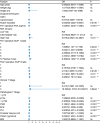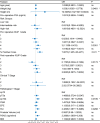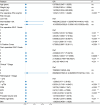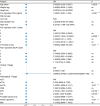Analysis of risk factors for persistent PSA after radical prostatectomy: results from a high-volume center in Southeast China
- PMID: 39210462
- PMCID: PMC11360676
- DOI: 10.1186/s12894-024-01563-z
Analysis of risk factors for persistent PSA after radical prostatectomy: results from a high-volume center in Southeast China
Abstract
Background: For localized prostate cancer, a comprehensive treatment approach centered around radical prostatectomy (RP) is often their optimal choice. Successful RP can typically reduce prostate-specific antigen (PSA) levels to below 0.1 ng/mL within 6 to 8 weeks postoperatively. However, in clinical practice, 5 to 24% of patients may have a PSA ≥ 0.1 ng/mL at 6 to 8 weeks after surgery, a phenomenon known as PSA persistence. Many studies based on data from Europe and United States have shown an association between PSA persistence and poor postoperative outcomes, further analyzing the risk factors for PSA persistence. However, relevant research based on data from China remains scarce.
Methods: Retrospective study of 1,347 prostate cancer patients who underwent RP at the First Affiliated Hospital of Zhejiang University School of Medicine from July 15, 2016, to August 31, 2022. Based on inclusion criteria, univariate and multivariate logistic regression analyses were conducted to explore the independent risk factors for persistent PSA.
Results: Among the 826 prostate cancer patients after RP, 124 patients experienced persistent PSA. In univariate logistic regression analysis, robot-assisted laparoscopic radical prostatectomy (RARP), preoperative PSA, high-risk group, preoperative International Society of Urological Pathology (ISUP) grades 2-5, postoperative ISUP grades 3-5, percentage of positive cores, cT3, ≥pT3b, extracapsular extension (EPE), seminal vesicle invasion (SVI), positive surgical margins (PSM) and Prostate Specific Antigen Density (PSAD) were all significantly associated with PSA persistence after RP (P < 0.05). In terms of surgical approach, RARP was considered a protective factor against postoperative PSA persistence (OR:0.53, p < 0.05). In multivariate logistic regression analysis, preoperative ISUP grade 4, percentage of positive cores and PSM were independent risk factors of PSA persistence after RP (P < 0.05).
Conclusion: Preoperative PSA, high-risk group, preoperative ISUP grades 2-5, postoperative ISUP grades 3-5, percentage of positive cores, cT3, ≥pT3b, EPE, SVI, PSM and PSAD were independent risk factors for PSA persistence in prostate cancer patients after RP. This provides assistance for early monitoring and treatment of patients at high risk of persistent PSA in clinical practice.
Keywords: PSA persistence; Prostate cancer; Radical prostatectomy; Risk factors.
© 2024. The Author(s).
Conflict of interest statement
The authors declare no competing interests.
Figures






References
-
- Han B, Zheng R, Zeng H, Wang S, Sun K, Chen R et al. Cancer incidence and mortality in China, 2022. Journal of the National Cancer Center [Internet]. 2024 [cited 2024 Mar 18]; https://www.sciencedirect.com/science/article/pii/S2667005424000061 - PMC - PubMed
MeSH terms
Substances
Grants and funding
LinkOut - more resources
Full Text Sources
Medical
Research Materials
Miscellaneous

